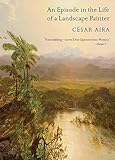 About mid-way through César Aira’s novel An Episode in the Life of a Landscape Painter, its protagonist, the German master of documentary painting Johann Moritz Rugendas and his assistant are crossing the Argentinean Pampas somewhere between Mendoza and San Luis. They ride over a vast, featureless plain. Soon they come to an even more desolate landscape.
About mid-way through César Aira’s novel An Episode in the Life of a Landscape Painter, its protagonist, the German master of documentary painting Johann Moritz Rugendas and his assistant are crossing the Argentinean Pampas somewhere between Mendoza and San Luis. They ride over a vast, featureless plain. Soon they come to an even more desolate landscape.
On the third day they came to expanses resonant with emptiness. The sinister nature of the surroundings made an impression on the Germans, and, to their surprise, on the Gauchos too. The old man and the boy talked in whispers, and the man dismounted on a number of occasions to feel the soil. They noticed that there was no grass, not the least blade, and the thistles had no leaves: they looked like coral.
It takes them some time to realize that this “lunar ocean” is the work of locusts who had swept through the land, leaving nothing behind. Rugendas sets out in search of water and fodder. Soon clouds gather:
The storm broke suddenly with a spectacular lightning bolt that raced a zig-zag arc clear across the sky. It came so close that Rugendas’ upturned face, frozen in an expression of idiotic stupor, was completely bathed in white light. He thought he could feel its sinister heat on his skin, and his pupils contracted to pin-points. The thunder crashing down impossibly enveloped him in millions of vibrations. The horse began to turn beneath him. It was still turning when a lightning bolt struck it on the head. Like a nickel statue, man and beast were lit up with electricity. For one horrific moment, regrettably to be repeated, Rugendas witnessed the spectacle of his body shining. The horse’s mane was standing on end, like the dorsal fin of a swordfish.
That’s what reading Aira is like: you don’t know where you are or what you are looking at, but the air is full of electricity.
César Aira was born in Argentina in 1949, in the wonderfully named town of Colonel Pringles, the Wikipedia page of which promises visitors an Arbor of Historical Trees that was one visited by Jorge Luis Borges. Since 1967 he has lived in Buenos Aires. He is a writer of immense productivity, having written over sixty novels in addition to translations and works of criticism. Only four of his works are currently in print in English, which makes it difficult to evaluate the totality of his output except on the principle of the iceberg: there’s a lot more under the water than what we can see.
Roberto Bolaño called him the “one contemporary writer who defies classification,” but Anglophone readers will naturally tend to group him in the loose circle of writers who seem to move in Bolanño’s general orbit. Besides Aira, this informal Bolaño-kreis would include the Salvadorean writer Horacio Castellanos Moya and the Catalan Enrique Vila-Matas. But while the links between these two and Bolaño are reasonably clear – Moya shares his fascination with urban violence and the sinister underside of Latin American politics, and Vila-Matas his interest in creating a fully recursive literature – the connection to Aira is harder to specify.
Aira considers himself an experimental novelist. His working method relies on internal momentum, using what he calls the “continuum” or the “constant flight forward. This procedure allows him to overcome self-censorship and the burdens of traditional form. He writes a page or two a day, without revising or going backward until the book assumes its desired shape. This technique results in strange, brief novels which oscillate between the mundane and the fantastic multiple times over their short spans. The four available in English are works of compression, detail and mystery in which tightly controlled surfaces of prose are deployed in the service of haphazard curlicues of plot. In fact, it might be easier to treat the novels like ballads and summarize them along the lines of Harry Smith’s liner notes to the Anthology of American Folk Music:
An Episode in the Life of a Landscape Painter – Savage Indians and facial trauma await an artist in the pampas.
How I Became a Nun – Poisoned ice cream and illiteracy complicate a girl/boy’s first year of school.
Ghosts – Nudist specters urge a teenage girl to join them for a New Year’s Eve feast.
The Literary Conference – Pirate treasure helps poor writer clone an army out of Carlos Fuentes.
Of course, this doesn’t really do justice either to the books’ intricacy or to their wildness. But that’s all right, because plot is always a secondary concern in Aira. His novels are always about something in addition to themselves.
An Episode in the Life of a Landscape Painter, Aira’s masterpiece, is on the surface just what its title says it is: the story of a brief episode which marked a turning point in the career of the real-life German artist Johann Moritz Rugendas. Rugendas’ specialty was a now-forgotten branch of landscape painting propagated by Alexander von Humboldt and called the “physiognomy of nature,” which aimed to document the infinite forms of nature and resolve these into a discrete number of primary types. Following Humboldt’s advice, Rugendas comes to the New World in order to find landscapes worthy of his brush. The novel picks up in the middle of his travels across the continent, narrating a trip from Santiago to Buenos Aires which has to be cut short by a gruesome accident.
Over the course of its eighty-seven pages, Episode exposes readers to a Baedeker’s-worth of scenic spectacle and local color: hallucinatory vegetation, snow-capped peaks, lightning storms, Indian raids and endless plains. The effect of all this detail and incident on such a small canvas is vertiginous, like reading an epic poem etched on a grain of sand.
I’m making the novel sounds like something by a Latin American Larry McMurtry, but Aira’s method is closer to that of a miniaturist than a painter of history. Telling the story through Rugendas’ eyes, Aira’s prose acquires a rare intensity of vision. Here he is describing one of the immense carts used for hauling loads across the pampas:
Because they had only two wheels (that was their peculiarity), they tipped back when unloaded and their shafts pointed up at the sky, at an angle of forty-five degrees. The ends of the shafts seemed to disappear among the clouds; their length can be deduced from the fact that they could be used to hitch ten teams of oxen. The sturdy planks were reinforced to bear immense loads; whole houses, on occasion, complete with furniture and inhabitants. The wheels were like fairground Ferris wheels, made entirely of carob wood, with spokes as thick as roof-beams and bronze hubs at the center, laden with pints of grease.
I love those upturned shafts, which turn the humble cart into a Jacob’s ladder bridging earth and heaven, while the carob-wood wheels and bronze hubs call to mind something between a lumberyard appliance and a Viking trousseau. Looking at the cart, Rugendas feels compelled to follow it across the plains: “He felt it would be like traveling in time: proceeding rapidly on horseback along the same route, they would catch up with carts that had set off in other geological eras, perhaps even before the inconceivable beginning of the universe.”
As the novel moves forward, Rugendas, and Aira through him, comes closer and closer to an ideal of art as unmediated vision. The cost is considerable. Rugendas’ accident leaves him with a grotesquely deformed face and prone to terrible migraines, which he treats with tinctures of opium. It also intensifies his ability to see: “He had never seen better in his life. In the depths of that mantled night the pinpricks of his pupils woke him to the bright day’s panorama. And powdered poppy extract, a concentrated form of the analgesic, provided sleep enough for ten reawakenings per second.” By the end Rugendas is something not quite human, a “waking nightmare,” the star of a horror film whose monster is the Emersonian eyeball.
 Ghosts shares Episode’s preoccupation with the visible world, if in a less frenzied key. The entire action takes place over the course of a single day, New Year’s Eve, in and around a Buenos Aires construction site. The night watchman, a Chilean immigrant, and his family live in the unfinished building as squatters. The father, Raúl, is a good worker, but a bit of a drunkard. His wife, Elisa, is a levelheaded housewife, “that anomaly, not nearly as rare as is often supposed: a mother immune to the terrifying fantasy of losing her children in a crowd.” Their daughter, Patri, quiet but philosophically “frivolous,” spends the day wandering through the empty structure. All of them see the ghosts which haunt it: portly naked men covered in fine cement dust whose members stretch like accordions. The ghosts float between floors and sit on the satellite dishes “on which no bird would have dared to perch.” Raúl uses them to refrigerate his wine; inserting a bottle into the ghosts’ thorax not only cools the wine, but also transmutes it into an “exquisite, matured cabernet sauvignon.” Elisa does her best to ignore them. But Patri is drawn to them by a strange attraction, and they to her, swarming around her head in a “luminous helix.” Toward evening, they invite her to their midnight feast, though without mentioning the price of admission.
Ghosts shares Episode’s preoccupation with the visible world, if in a less frenzied key. The entire action takes place over the course of a single day, New Year’s Eve, in and around a Buenos Aires construction site. The night watchman, a Chilean immigrant, and his family live in the unfinished building as squatters. The father, Raúl, is a good worker, but a bit of a drunkard. His wife, Elisa, is a levelheaded housewife, “that anomaly, not nearly as rare as is often supposed: a mother immune to the terrifying fantasy of losing her children in a crowd.” Their daughter, Patri, quiet but philosophically “frivolous,” spends the day wandering through the empty structure. All of them see the ghosts which haunt it: portly naked men covered in fine cement dust whose members stretch like accordions. The ghosts float between floors and sit on the satellite dishes “on which no bird would have dared to perch.” Raúl uses them to refrigerate his wine; inserting a bottle into the ghosts’ thorax not only cools the wine, but also transmutes it into an “exquisite, matured cabernet sauvignon.” Elisa does her best to ignore them. But Patri is drawn to them by a strange attraction, and they to her, swarming around her head in a “luminous helix.” Toward evening, they invite her to their midnight feast, though without mentioning the price of admission.
Between hauntings, Ghosts is filled with Aira’s beautifully precise observation of the texture of everyday life. Most of the novel is occupied with the description of a workday, the preparations for a lunch, the problem of getting change in a grocery store, the difference between Chilean and Argentinean hair styles, laundry. Elisa uses an inordinate amount of bleach in her washing, with the result that her family’s clothes “were so faded and had that threadbare look, humble and worn, yet beautifully so. Even if an article of clothing was new, or brightly colored when she bought it, for the very first wash (a night-long soak in bleach) it took on the whitish, delicate and somehow aristocratic appearance that distinguished the clothes of the Viñas family.” Viewed from this close, ordinary existence opens out to other dimensions. Aira is a master at pivoting between the mundane and metaphysical. In the middle of Ghosts, Patri takes a nap during the siesta and dreams of her unfinished building. Her dream turns into a disquisition on the problem of the unbuilt in the arts, on the philosophical underpinnings of architecture in different cultures, and finally, a blueprint for Aira’s brand of literature, “an art in which the limitations of reality would be minimized, in which the made and the unmade would be indistinct, an art that would be instantaneously real, without ghosts.”
 How I Became a Nun begins with a cone of poisoned ice cream, part of a wave of lethal contaminations which was “sweeping Argentina and the neighboring countries that year.” Despite appearances, it is another attempt by Aira to create a literature of unmediated experience. This is a quest which runs through all of his work. Near the end of Episode in the Life of a Landscape Painter, Rugendas experiences something like it with regard to the visible world while in the grip of an opium trance: “We come up against the words, and before we know it, we are already emerging on the other side, grappling with the thought of another mind. Mutatis mutandis, the same thing happens with a painter and the visible world…. What the world was saying was the world….Reality was becoming immediate, like a novel.” Aira’s strange framing conceits work like the inverse of Barthes’ reality effect. Grounding his novels in the extraordinary gives him the space to tunnel into the everyday world, Francis Ponge by way of Kobo Abe.
How I Became a Nun begins with a cone of poisoned ice cream, part of a wave of lethal contaminations which was “sweeping Argentina and the neighboring countries that year.” Despite appearances, it is another attempt by Aira to create a literature of unmediated experience. This is a quest which runs through all of his work. Near the end of Episode in the Life of a Landscape Painter, Rugendas experiences something like it with regard to the visible world while in the grip of an opium trance: “We come up against the words, and before we know it, we are already emerging on the other side, grappling with the thought of another mind. Mutatis mutandis, the same thing happens with a painter and the visible world…. What the world was saying was the world….Reality was becoming immediate, like a novel.” Aira’s strange framing conceits work like the inverse of Barthes’ reality effect. Grounding his novels in the extraordinary gives him the space to tunnel into the everyday world, Francis Ponge by way of Kobo Abe.
How I Became a Nun is a novel about childhood. It also contains one of the best sentences and the worst pun in recent literature. The sentence is an unprovable conjecture about semantic limits of sign language: “In the language of gestures, the dwarf must be unsayable.” For the pun, you’ll have to read the book to the end. After the poisoning, it settles into an episodic narrative about a year in the life of a child, a girl named César Aira, whom the world seems to regard as a boy. Very little is made of this ambiguity. Even less is made of the vampire plague which pops up in the background.
For the most part, little César’s childhood is fairly normal. After the second chapter, César’s father is in jail and her mother struggles to provide for the family, but otherwise he/she undergoes the usual adventures of being a seven-year old: learning to read, making a friend, listening to the radio, playing make believe. Aira has a gift for inhabiting the particular logic of children, with its excess of thought without sense to guide it. César alternately under- and overreacts to events, throws fits, tells strange, pointless lies, misunderstands wholes sets of concepts. She arrives in school after a three month absence and doesn’t know how to read. The process appears to her as an “abstract mimicry,” a “recondite algebra in which the teachers specialized for reasons that were none of my concern.” Visiting her father in prison she hides for a day and a night, fantasizing about the search provoked by her disappearance. Asked by a doctor about her symptoms while recuperating in the hospital, César launches into a typically elaborate dishonesty:
An urge, a whim or a manic obsession that not even I could explain impelled me to sabotage the doctor’s work, to trick him. I pretended to be stupid…I must have thought the opportunity was too good to waste. I could be as stupid as I liked, with impunity. But it wasn’t simply a matter of passive resistance. Doing nothing at all was too haphazard, because sometimes nothing can be the right response, and I was determined not to let chance determine my fate. So even though I could have left his questions unanswered, I took the trouble to answer them. I lied. I said the opposite of the truth, or the opposite of what seemed truest to me.
This passage gives me a pang of recognition. César’s convoluted rationales recall the dimly remembered reasons behind various childhood decisions, like building a fort and then destroying it to keep it from being destroyed, or hiding for hours among the women’s wear racks in a Value City in hopes of raising an alarm. In its own way, it’s a triumph of psychological realism. Certainly it’s a tremendous relief after years of American fiction in which are children are confined to the axis of angel, savant and thug.
 In The Literary Conference, the most recent and most antic of his novels to appear in English, Aira is once again his own protagonist. This time he is an adult, and male, an author of middling renown and a struggling translator. He is also a master of genetics and genius at solving nautical puzzles, a skill which he uses in the prologue to raise an ancient treasure from the Venezuelan seafloor. Still, César is afflicted by the same mental hyperactivity that plagued him in How I Became a Nun: “Everything is a metaphor in the hyperkinetic microscope of my psyche, everything is instead of something else.”
In The Literary Conference, the most recent and most antic of his novels to appear in English, Aira is once again his own protagonist. This time he is an adult, and male, an author of middling renown and a struggling translator. He is also a master of genetics and genius at solving nautical puzzles, a skill which he uses in the prologue to raise an ancient treasure from the Venezuelan seafloor. Still, César is afflicted by the same mental hyperactivity that plagued him in How I Became a Nun: “Everything is a metaphor in the hyperkinetic microscope of my psyche, everything is instead of something else.”
This torrent makes it hard for him to unwind. In between the raising of the treasure and the fulfillment of his diabolical plan for world domination (or Latin American literary respectability), he takes a brief vacation at a literary conference, but he can’t relax, distracted by the “thousands of tiny incidents, all full of meaning” that happen “while nothing was happening.” At one point he tries to measure the velocity of his thoughts:
I am trying a method of my own invention: I shoot a perfectly empty thought through all the others, and because it has no content of its own, it reveals the furtive outlines – which are stable to the empty one – of the contents of the others. That retrograde cloned mini-man, the Speedometer, is my companion on solitary walks and the only one who knows all my secrets.
He could be talking about his own work as a writer. Everything in Aira has that Mad Scientist feel to it. His novels are eccentric clones of reality, where the lights are brighter, the picture is sharper and everything happens at the speed of thought.








